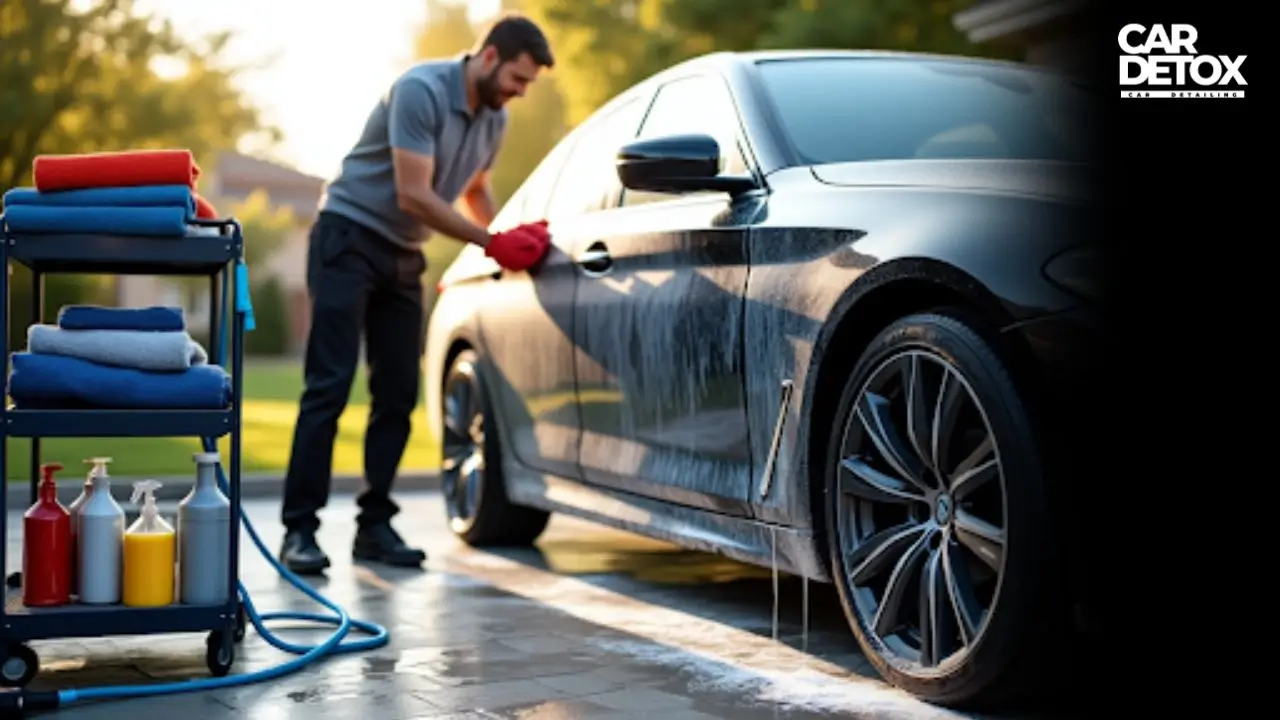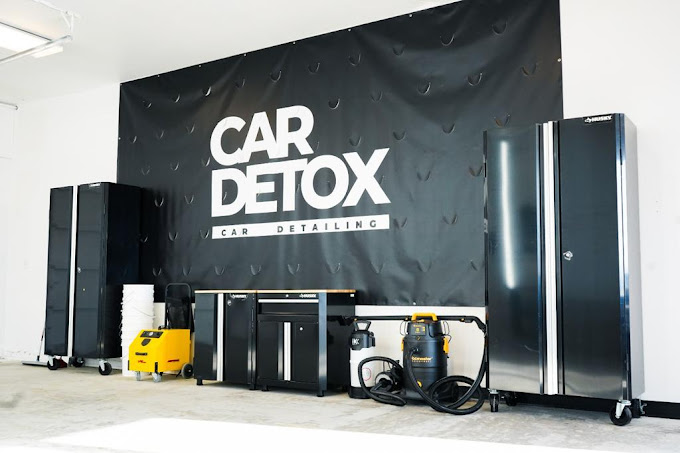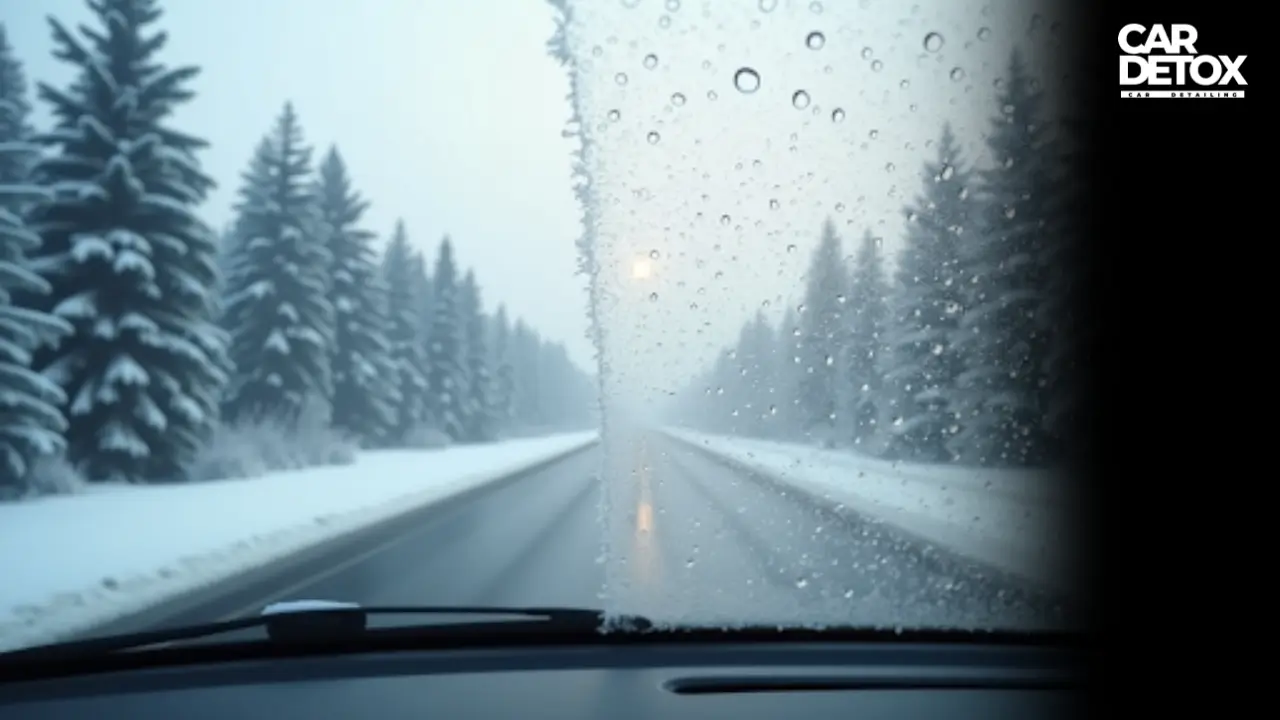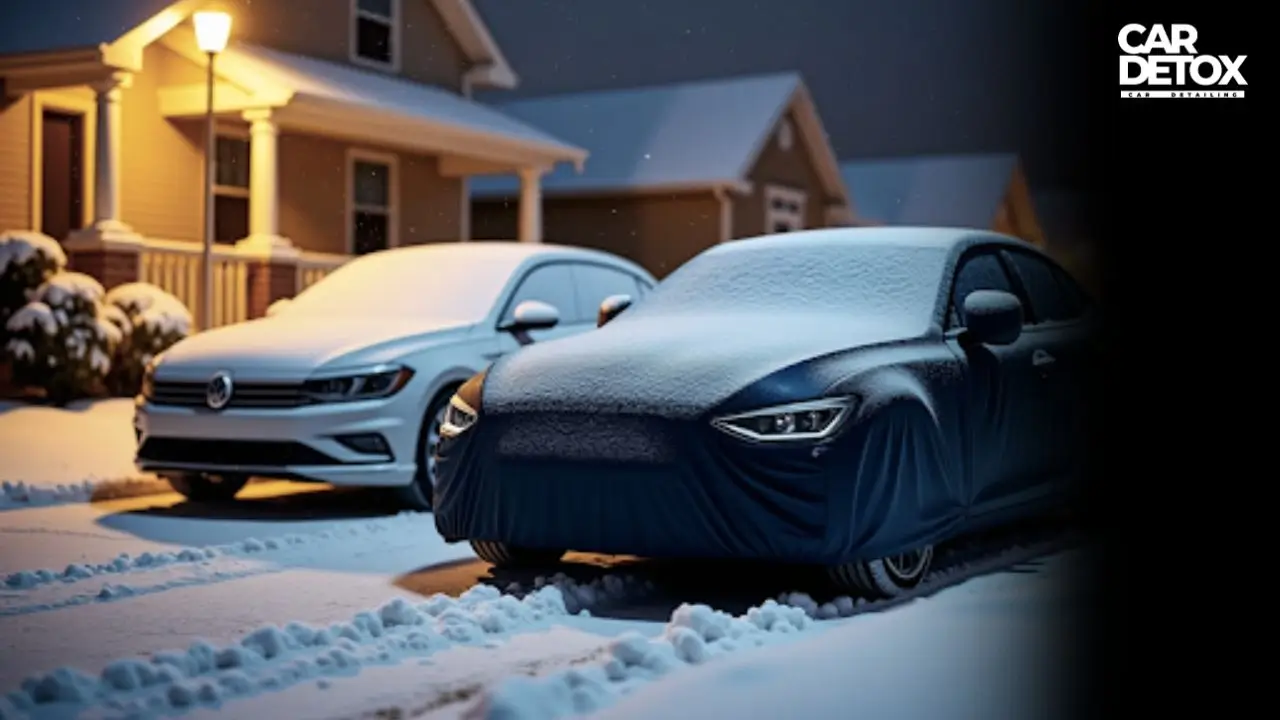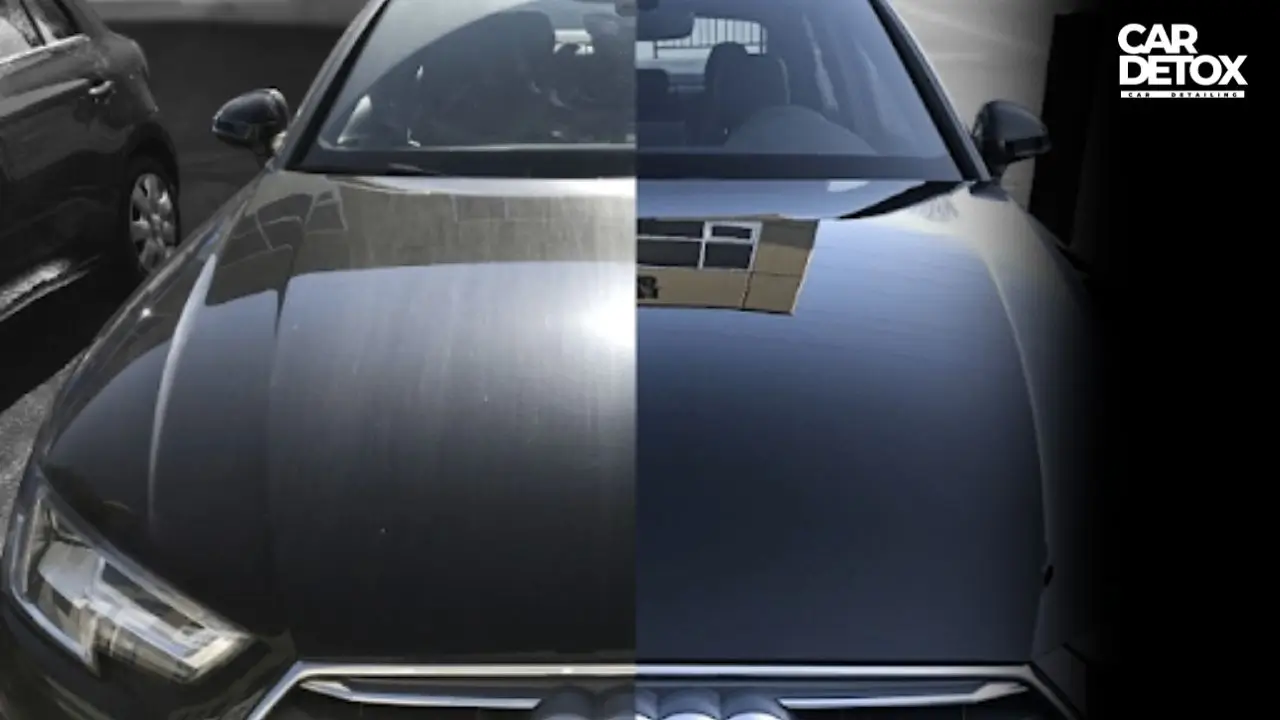Your car can keep its showroom shine for up to 6 months with proper exterior detailing.
Professional car exterior detailing does more than just make your car shine. It protects your paint, stops corrosion, improves visibility, and preserves your car's resale value by a lot. Professional detailers can even remove years of scratches, damage, and wear from your car's surface.
Getting professional-level results at home might seem tough. We created this detailed guide to help you become skilled at car exterior detailing. You'll learn everything from picking the right tools to mastering proper cleaning techniques. We'll also cover advanced methods like paint decontamination and protection to help you transform your car step by step. For those in the Portland area, Car Detox offers expert services like ceramic coating, smoke odor removal, and fleet detailing to ensure your vehicle looks its best.
Want to give your car that head-turning showroom shine? Let's take a closer look at the professional techniques and expert tips that will help you detail your car's exterior like a pro.
Essential Tools and Products for Exterior Car Detailing
Invest in professional-grade supplies like pH-balanced shampoos and clay bars. For long-term protection, ceramic coatings (like Rivian ceramic coating) are a game-changer. Local services such as mobile car detailing Portland and auto detailing Happy Valley rely on these products to deliver flawless results.
Professional-grade cleaning supplies
Professional detailers use specialized products that work better than generic options. Your car's paint needs a pH-balanced car wash soap to safely remove dirt. Regular household soaps can strip protective coatings, while proper car shampoos give you the lubrication needed to prevent scratches during washing.
Clay bars are vital tools that remove embedded contaminants from your paint surface and leave it smooth. You'll need to pick between waxes, sealants, and ceramic coatings for protection. While carnauba wax gives a deep shine but needs frequent application, ceramic coatings last longer and protect better.
You'll also need specific cleaners for each surface – glass cleaner for windows, wheel cleaner for rims, and tire dressing to get that professional look. All-purpose cleaners help you tackle everything from door jambs to plastic trim.
Microfiber towels and applicators
Quality microfiber towels might be your best investment in car detailing. These towels don't just push dirt around like cotton ones - their tiny fibers lift and trap contaminants. They can hold up to eight times their weight in water, which makes drying quick and easy.
Here's what matters when buying microfiber towels:
- Polyester/polyamide ratio – more polyester means softer towels
- GSM (grams per square meter) – higher numbers give you more plushness and absorbency
- Edging – borderless designs help avoid scratches from stitched edges
Foam and microfiber applicators help you apply waxes, sealants, and tire dressings properly. Look for soft materials made specifically to protect your vehicle's paint and finishes.
Pressure washers vs. garden hoses
Electric pressure washers and garden hoses each have their place in car cleaning. Pressure washers offer clear advantages:
- Settings you can adjust for different cleaning needs
- Less water waste than garden hoses
- Cleaning gets done faster
- Strong jets clean hard-to-reach spots better
Garden hoses work better for cars with delicate surfaces or aging paint. They're safer than pressure washers, which can damage paint if not used correctly. Most detailers prefer electric pressure washers with adjustable settings because they balance power and control.
Budget-friendly alternatives
Great results don't require expensive tools. Many household items work just as well as specialized products. Baby shampoo cleans cars effectively because it lubricates well and has mild cleaning power.
Natural options like vinegar for glass, baking soda for upholstery, and castile soap for washing can give excellent results while staying eco-friendly. Simple tools like toothbrushes clean tight spaces well, and melamine sponges tackle tough stains.
Dollar store foam sponges work great as tire dressing applicators. Cheesecloth helps remove stubborn bugs from bumpers and mirrors gently.
Note that successful car detailing depends on technique as much as tools. Even budget options give impressive results when used properly.
Preparing Your Car for a Deep Clean
Always work in shaded areas to avoid water spots—Portland’s unpredictable weather makes garages or driveways ideal. If you’re short on time, mobile car wash Portland services can handle the pre-wash grind, especially for fleet vehicles or cars with heavy contamination.
Choosing the right location and time
Your work environment can really affect your detailing quality. You should never detail your car in direct sunlight. The sun makes cleaning products dry too fast and leaves water spots and streaks on your paint. Working indoors or in a shaded spot works best. Make sure all exterior surfaces feel cool before you start.
Temperature matters a lot too. The sweet spot for detailing is in the shade when it's between 65-75°F. Very hot or cold weather can mess with how products stick to your car's surfaces.
You need enough space to move freely around your car. Having room to open all doors and reach every panel without bumping into things makes a big difference. Mobile detailing services should check for stable ground without any tree branches or yard tools that could scratch the car.
Pre-wash inspection
Looking over your car before using any products gives you the full picture. I always check my car for heavy dirt, scratches, and tough stains. This helps me plan how to tackle problem spots.
Taking before pictures helps in two ways:
- Shows you the difference after detailing
- Documents existing damage, which really helps if you're using a pro detailer
Look carefully for:
- Paint flaws and scratches
- Heavy contamination spots (tree sap, bird droppings)
- Dirty door jambs and seals
- Oxidation or fading signs
This inspection shows you what kind of deep cleaning your car might need later.
Removing loose debris
Getting rid of loose dirt first keeps your paint safe during washing. Water comes first - I rinse the whole car to knock off loose dirt before touching the paint.
Start at the top and work down since dirt flows downward naturally. A hose or pressure washer helps blast really dirty spots, usually the lower parts and wheel wells.
Next comes a good pre-cleaner that breaks down tough grime. This stuff removes what water can't touch. Let it sit for a few minutes to dissolve dirt and road film before rinsing.
This pre-wash step really matters - it cuts down swirl marks you might get during the main wash. Pro detailers know that removing dirt before touching the paint keeps finishes swirl-free.
These prep steps create the base for great detailing results that protect your car's finish at a professional level.
The Step-by-Step Exterior Cleaning Process
Start with wheels and tires—car detailing Tualatin pros swear by non-acid cleaners to protect rims. Use the two-bucket method to minimize scratches, and don’t forget door jambs! For busy business owners, commercial fleet detailing services streamline this process across multiple vehicles.
Wheels and tires first approach
Your car's exterior detailing success depends on starting with the wheels and tires. These parts collect brake dust and road grime that might contaminate other areas if you clean them later. Starting here prevents dirty water from splashing onto clean surfaces.
Here's what works best:
- Clean one wheel at a time instead of putting cleaners on all four wheels at once
- Use non-acid wheel cleaners that match your wheel type
- Let the cleaner sit briefly before scrubbing with the right brushes
- Rinse each wheel completely after cleaning
This method helps prevent cross-contamination, and that's why many professionals keep separate buckets and tools just to clean wheels and tires.
Two-bucket washing method
The two-bucket method is the best way to wash your car safely after cleaning the wheels. This technique keeps clean and dirty water separate and reduces the risk of scratches and swirl marks.
Your bucket setup should be:
- Bucket #1: Car shampoo solution (wash bucket)
- Bucket #2: Clean water only (rinse bucket)
Start by soaking your wash mitt in soap solution. After washing each section, dip the mitt in the rinse bucket to remove dirt before adding fresh soap. Working from top to bottom lets dirt flow onto unwashed areas, which makes the process more efficient.
Proper drying techniques
Drying your car is just as vital as washing it. Water spots can damage your paint if you let the car air-dry. You have several good options to dry your car:
Microfiber towels work best when you blot instead of wipe. This reduces friction against the paint. Waffle-weave microfiber towels are great at absorbing water quickly.
A leaf blower or dedicated car dryer gives you a hands-free option that works really well for crevices, emblems, and spots that are hard to reach.
Cleaning door jambs and hidden areas
Door jambs need special attention because they often get overlooked. These spots collect dirt, grime, and moisture that could lead to rust.
Here's how to clean door jambs:
- Spray all-purpose cleaner (mixed 4:1 with water) into the jambs
- Use small brushes to clean, and be careful around electrical parts
- Clean with microfiber towels until all soap is gone
- Add quick detailer or spray wax to protect the surface after it dries
Note that you should clean all door edges, under-areas, and spaces around A, B, and C-pillars where dirt builds up.
Paint Decontamination and Protection
After claying, consider ceramic coating services in Portland for unmatched durability. Stubborn issues like smoke residue or mold? Car Detox specializes in smoke smell removal service and mold removal Tualatin, ensuring every inch of your car feels fresh.
Clay bar treatment
Clay bars are special products that pull stuck-on contaminants from your clear coat without hurting the paint. They remove industrial fallout, brake dust, metal particles, and road grime that regular washing doesn't touch.
A quick way to check if your car needs clay bar treatment:
- Run your fingertips across the clean paint
- The presence of tiny bumps means your paint has trapped contaminants
The clay bar works best when you:
- Break off a small piece of clay and flatten it into a disk
- Spray lubricant generously on the clay and a small section of paint
- Glide the clay back and forth with light pressure
- Wipe away residue with a microfiber towel
- Knead the clay to expose a clean surface as it picks up dirt
Your whole vehicle needs treatment before you apply any protection products. The clay bar should go straight in the trash if you drop it - ground particles can scratch your paint.
Chemical decontaminants for stubborn residues
Start with chemical decontamination before using clay bars since it's easier on your paint. Iron removers turn metallic contaminants into water-soluble substances that rinse away easily.
Spray your chosen fallout remover on the vehicle's surface and let it sit for 3-4 minutes. The product changes color when it reacts with iron particles. Give everything a good rinse with water before moving on to mechanical decontamination.
Wax vs. sealant vs. ceramic coating
The right protection choice depends on what you want in terms of durability, looks, and water-beading properties:
Wax: Carnauba palm trees give us natural wax that adds depth and a warm, rich glow to paint. The downside? It only lasts 4-8 weeks and melts at temperatures between 160-180°F.
Sealant: These synthetic polymers create a glass-like finish that lasts 6-12 months. They guard against UV rays, chemicals, and contaminants better than wax.
Ceramic Coating: This top-tier paint protection uses silicon dioxide (SiO2) that bonds with your paint. It costs more and needs careful application, but you get amazing water-beading properties and protection that lasts up to 5 years.
A ceramic coating applied after proper decontamination gives you the best long-term protection.
Finishing Touches for a Showroom Shine
Polish chrome trim and restore foggy headlights—auto detailing Tigard teams often use UV sealants to prevent re-oxidation. For tires, a satin-finish dressing adds that final “wow” factor.
Glass and window cleaning
Clean, streak-free windows look great and keep you safe. You should roll down windows a bit to clean the top edges that people often miss. The best method uses an ammonia-free glass cleaner on a microfiber towel instead of spraying windows directly. This prevents overspray. A three-towel system works best. One towel applies cleaner, another removes excess product, and a third low-nap glass-specific microfiber gives the final buff. Use minimal glass cleaner to avoid streaks. The work should happen in the shade on cool surfaces.
Tire and trim dressing
Your car's appearance improves instantly with well-dressed tires. Water-based dressings give a satin finish without oily residue - perfect for that factory-fresh look. Solvent-based products work better for a glossier, wet look. The application technique is vital whatever your choice. Put the dressing on an applicator pad and spread it evenly on the tire face. A microfiber cloth removes excess product to prevent sling. Let products dry for 10-20 minutes before driving.
Headlight restoration
Foggy, yellow headlights look bad and reduce safety. Simple household items like toothpaste or a baking soda/vinegar mix can fix light hazing. Use circular motions with a microfiber cloth for 5-10 minutes on each headlight. Badly oxidized lenses need wet sanding with finer grits from 800 to 2000, followed by polishing compound. A coat of car wax or UV sealant stops re-oxidation.
Chrome and metal polishing
Bright metal surfaces give that classic showroom look. Heavy metal polishes with larger abrasives work on neglected, oxidized surfaces. Light metal polishes with finer abrasives are better for maintenance. Put a small amount on a microfiber applicator and work in straight lines to avoid swirls. A clean microfiber towel buffs the surface. This brings back shine and protects against future contamination.
Conclusion
Achieving a pro-level shine takes patience, but the results speak for themselves. If DIY isn’t your style, Car Detox offers comprehensive solutions, from ceramic coating Portland to fleet vehicle detailing. Serving Happy Valley, Sherwood, Beaverton, and beyond, their mobile car detailing Portland team brings convenience and expertise to your doorstep. Protect your investment with advanced treatments like paint correction or car detailing smoke odor removal, and keep your fleet spotless with tailored fleet detailing prices. Ready to transform your car? Let the pros handle the dirty work—your showroom-ready ride awaits!
Our Popular Services
Car Detailing Services | Ceramic Coating Services | Pet Hair Removal Services | Mobile Auto Detail Services Happy Valley | Car Detailing Services in Tualatin
Find Us On Map
Car Detox - Auto Detailing Services
Book An Appointment
Read More on
How Long Do Interior Ceramic Coatings Last?
Is Ceramic Coating Better Than Wax?
How to Find the Best Ceramic Coating Installer Near Me
How long does ceramic coating take to cure?
Revive your ride anytime, anywhere
Schedule AppointmentQuestions? Call us now!

